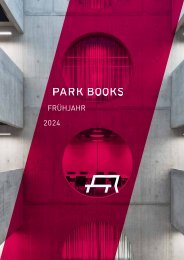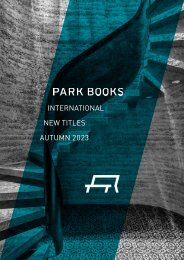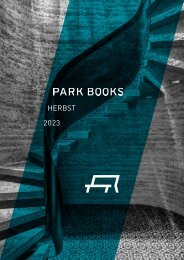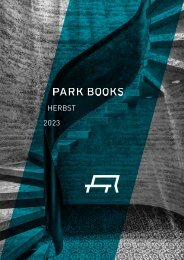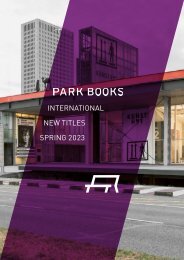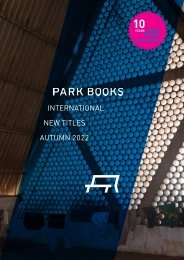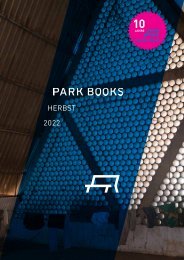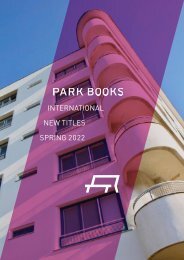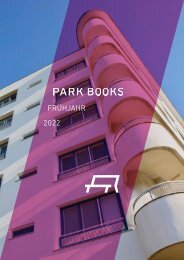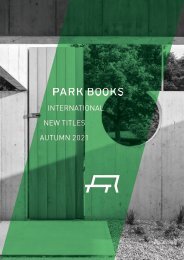Intern-new-titles-Park-Books-2019-20-lowres
New Titles Cataloug 2019/20
New Titles Cataloug 2019/20
Create successful ePaper yourself
Turn your PDF publications into a flip-book with our unique Google optimized e-Paper software.
First in-depth investigation of Allied forces’<br />
policies in occupied Austria during the Cold War<br />
and their impact on the country’s architecture<br />
and building activity<br />
Shows how British, American, French, and<br />
Soviet cultural policies served as catalysts for<br />
their respective ideological convictions<br />
Lavishly illustrated with previously<br />
unpublished images, documents and plans<br />
from international archives<br />
Architecture as part of a global<br />
struggle of differing political<br />
systems: with its transnational<br />
perspective, this book changes<br />
our view of architectural<br />
history and postwar society<br />
Following the liberation and subsequent occupation of Austria at the end of World War<br />
II in spring 1945 by the victorious powers Britain, France, the United States, and the Soviet<br />
Union, Vienna soon became a central stage for the quickly emerging Cold War. The<br />
struggle of differing political systems was also carried out in the field of architecture.<br />
Cold War and Architecture sheds <strong>new</strong> light on the building activity in postwar Austria and<br />
its main protagonists. For the first time, this book explores the lines of architectural<br />
debates of the time in the context of the global political and cultural conflict of East vs.<br />
West. With its transnational perspective, it changes our view of architectural history<br />
and postwar society.<br />
During the ten-year occupation period, Austria experienced a transition from authoritarian<br />
government to democratic consumer society. Each of the four Allied powers<br />
established its own extensive cultural program. Architectural exhibitions became important<br />
instruments of such educational schemes with the objective of a <strong>new</strong> social<br />
order. British, American, French, and Soviet cultural policies thus served as catalysts<br />
for ideological convictions.<br />
Monika Platzer is a Curator and Head of Special<br />
Collection at Architekturzentrum Wien. She<br />
also lectures at Universität Wien and Technische<br />
Universität Wien and has been a visting<br />
scholar at Harvard University in <strong>20</strong>14.<br />
Monika Platzer<br />
Cold War and Architecture<br />
The Competing Forces that Reshaped Austria<br />
after 1945<br />
Translated by Elise Feiersinger and Brian<br />
Dorsey. Edited by Architekturzentrum Wien<br />
Az W<br />
Paperback<br />
approx. 300 pages, <strong>20</strong>0 color and<br />
50 b/w illustrations<br />
<strong>20</strong> × 27 cm (7¾ × 10¾ in)<br />
978-3-03860-175-3 English<br />
978-3-03860-168-5 German<br />
sFr. 65.00 | € 58.00 | £ 50.00 | $ 65.00<br />
January <strong>20</strong><strong>20</strong> (Europe) | April <strong>20</strong><strong>20</strong> (US)<br />
EN<br />
GE<br />
ISBN 978-3-03860-175-3 ISBN 978-3-03860-168-5<br />
NEW TITLES 16/17







